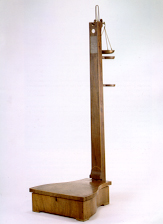
41 x 38.5 x 113
Wood and copper
INDEX 1790 : E.III.115
Statera Sanctoriana Londini inventa.
Sanctorian balance invented in London.
The adjective sanctoriana, used in the text from the Index of 1790 refers to the notable Italian doctor Santorio Santorio (1561-1636), a contemporary of Galileo, one of the first people to dedicate himself to the quantitative study of certain phenomena, like, for example, the loss of weight suffered by the human organism in different situations, while in rest or in movement, while sleeping or awake, etc. Santorio studied the variations of weight undergone by his own body systematically, during more than thirty years, imagining, for this purpose, a balance whose pans were large enough for the investigator to install himself in, sleep and eat in.
The Santorian balance in the Gabinete de Física in Coimbra was not made for such experiments but is a model of this type of balance. Seeing as it was made to support very heavy weights in one of its pans, it is credible that for this reason, in the Catalogue of 1878, it was called "a model of a balance for weighing loaded carts".
It consists of a small beam with uneven arms which move around a fixed point. There is a copper pan suspended from the longer arm; suspending from the shorter one there is a long wire, hidden in the interior of a prismatic wooden column, whose lower end is attached to a system of articulated parts which constitute the other pan of the balance. These parts are ordered horizontally and are also hidden in another wooden box which makes up the base of the balance, and whose lid can be lifted. On the column, there are also two wooden pans that are placed horizontally, but can move around by means of hinges, which allow them to decline.
The column measuring 91cm in length possesses, on its higher level, besides the space necessary for the wire attached to the end of the shorter beam to pass through, a crack through which a wooden ruler can pass so that it either comes out of the column or remains completely enclosed in it. The ruler is graduated in feet in an extension of three of these units. Each foot is divided into 12 equal parts (inches) and these in 8 equal parts each. On the top of the ruler, on the horizontal, is a fixed brass spindle, 28.5 cm long. The use of the spindle and the ruler are unknown.
As the Index 1790 states, this balance is of English origin. The inscription on the top of one of the surfaces of the support provides proof of this: HENRY KETTLE N.º 23 ST PAULS CH-YARD.
Dalla Bella describes this balance in number 115 of the Index of 1790. However, the inscription reads E.III. 585 (see last paragraph of instrument 5).
Carvalho, Rómulo de, História do Gabinete de Física da Universidade de Coimbra, Universidade de Coimbra, Biblioteca Geral, Coimbra, 1978, pp. 675-676.